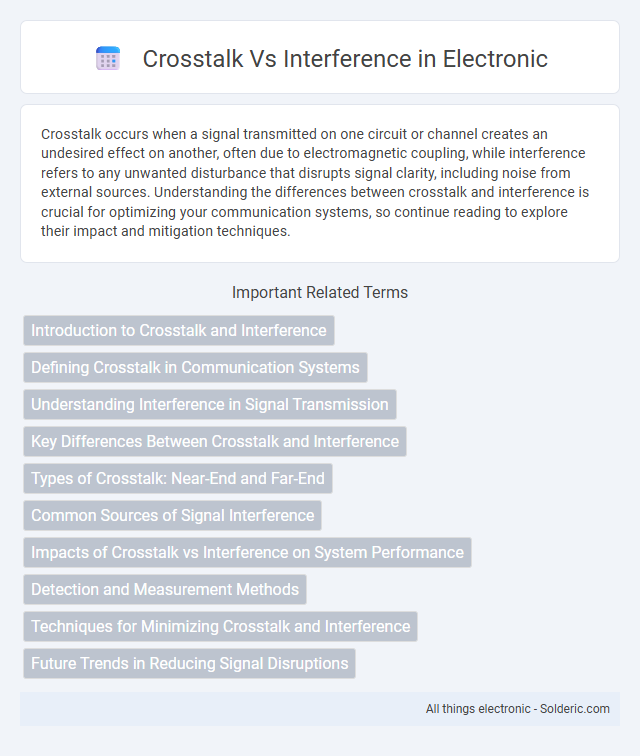Crosstalk occurs when a signal transmitted on one circuit or channel creates an undesired effect on another, often due to electromagnetic coupling, while interference refers to any unwanted disturbance that disrupts signal clarity, including noise from external sources. Understanding the differences between crosstalk and interference is crucial for optimizing your communication systems, so continue reading to explore their impact and mitigation techniques.
Comparison Table
| Feature | Crosstalk | Interference |
|---|---|---|
| Definition | Unwanted signal coupling between adjacent communication channels or circuits. | Any external or internal electromagnetic disturbance affecting signal quality. |
| Source | Electromagnetic coupling between conductors or circuits. | External sources like radio waves, electrical noise, or other electronic devices. |
| Effect | Signal degradation causing noise or cross-communication. | Signal distortion, noise increase, or data loss. |
| Common in | Wired communication cables, PCB traces, telephone lines. | Wireless signals, electronic circuits, power lines. |
| Mitigation | Shielding, twisting wires, proper spacing, differential signaling. | Filtering, shielding, grounding, frequency management. |
Introduction to Crosstalk and Interference
Crosstalk is the unwanted transfer of signals between communication channels, typically occurring in wired or wireless transmissions due to electromagnetic coupling. Interference encompasses a broader range of disturbances, including crosstalk, caused by external sources such as electromagnetic radiation, radio frequency noise, or physical obstacles. Understanding the distinctions between crosstalk as a specific form of interference and general interference helps in optimizing signal integrity and improving communication system performance.
Defining Crosstalk in Communication Systems
Crosstalk in communication systems refers to the unwanted transfer of signals between communication channels, causing signal degradation and reducing data integrity. It occurs primarily in twisted pair cables, telephone lines, and PCB traces when electromagnetic interference from one channel induces noise in another adjacent channel. Understanding crosstalk is essential for designing effective shielding and filtering techniques to minimize signal distortion and maintain high-quality communication performance.
Understanding Interference in Signal Transmission
Interference in signal transmission refers to unwanted disturbances that degrade the quality and clarity of the signal, often caused by external electromagnetic sources or overlapping signals. Crosstalk is a specific type of interference where signal leakage occurs between adjacent communication channels, leading to unintended signal mixing and reduced transmission fidelity. Identifying and minimizing interference, particularly crosstalk, is crucial for maintaining signal integrity in telecommunications and networking systems.
Key Differences Between Crosstalk and Interference
Crosstalk refers to the unwanted transfer of signals between communication channels, often occurring in adjacent wires or circuits, while interference encompasses a broader range of unwanted noise from external sources affecting signal quality. The primary difference lies in origin--crosstalk is an internal issue within the communication system, whereas interference typically arises from external electromagnetic sources such as radio frequency signals or electrical devices. Understanding these distinctions helps you identify and mitigate signal degradation effectively in telecommunications and networking environments.
Types of Crosstalk: Near-End and Far-End
Near-End Crosstalk (NEXT) occurs when a signal transmitted on one pair of wires creates unwanted interference measured at the transmitting end, commonly impacting Ethernet cables. Far-End Crosstalk (FEXT) happens when interference is detected at the receiving end of the cable pair, often degrading signal quality over longer distances. Both types of crosstalk are critical factors in high-frequency transmission lines and are mitigated through cable design improvements and shielding techniques.
Common Sources of Signal Interference
Common sources of signal interference include electromagnetic emissions from nearby electronic devices, power lines, and wireless transmitters that disrupt signal integrity. Crosstalk specifically arises from unwanted signal coupling between adjacent communication channels, often due to poor cable shielding or close proximity of wires within a cable bundle. Effective mitigation involves using twisted pair cables, proper grounding, and electromagnetic shielding to minimize both crosstalk and broader interference.
Impacts of Crosstalk vs Interference on System Performance
Crosstalk causes signal degradation by introducing unwanted coupling between adjacent communication channels, leading to increased error rates and reduced data integrity. Interference results from external electromagnetic sources disrupting signal transmission, causing noise and potential loss of synchronization in electronic systems. Both crosstalk and interference degrade system performance by lowering signal-to-noise ratio (SNR), but interference often poses a higher risk due to its unpredictable and broad-spectrum nature.
Detection and Measurement Methods
Crosstalk detection primarily involves time-domain reflectometry (TDR) and near-end crosstalk (NEXT) measurements, which identify unwanted signal coupling between adjacent channels in cables and circuits. Interference measurement utilizes spectrum analyzers and signal analyzers to quantify electromagnetic interference (EMI) and radio frequency interference (RFI) within specific frequency bands. Precise detection depends on utilizing vector network analyzers (VNAs) to assess signal integrity, transmission loss, and the degree of signal distortion caused by both crosstalk and interference phenomena.
Techniques for Minimizing Crosstalk and Interference
Techniques for minimizing crosstalk and interference include the use of twisted pair cables, which reduce electromagnetic coupling between adjacent wires, and implementing proper shielding, such as foil or braided shields, to block external noise sources. Maintaining adequate physical separation between signal lines and employing differential signaling can further decrease the impact of unwanted interference. Ensuring these practices in your network setup enhances signal integrity and improves overall communication reliability.
Future Trends in Reducing Signal Disruptions
Emerging technologies like advanced shielding materials and adaptive signal processing algorithms are significantly improving the ability to minimize crosstalk and interference in communication systems. Machine learning models are increasingly utilized to predict and mitigate signal disruptions in real-time, enhancing the reliability of data transmission. Your network's performance can benefit from these innovations, ensuring clearer signals and stronger connectivity in future communication infrastructures.
Crosstalk vs interference Infographic

 solderic.com
solderic.com